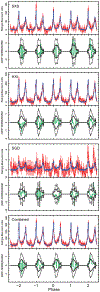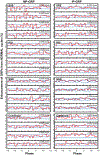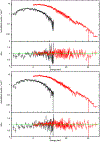Hitomi X-ray studies of Giant Radio Pulses from the Crab pulsar
- PMID: 32020916
- PMCID: PMC6999749
- DOI: 10.1093/pasj/psx083
Hitomi X-ray studies of Giant Radio Pulses from the Crab pulsar
Abstract
To search for giant X-ray pulses correlated with the giant radio pulses (GRPs) from the Crab pulsar, we performed a simultaneous observation of the Crab pulsar with the X-ray satellite Hitomi in the 2 - 300 keV band and the Kashima NICT radio observatory in the 1.4 - 1.7 GHz band with a net exposure of about 2 ks on 25 March 2016, just before the loss of the Hitomi mission. The timing performance of the Hitomi instruments was confirmed to meet the timing requirement and about 1,000 and 100 GRPs were simultaneously observed at the main and inter-pulse phases, respectively, and we found no apparent correlation between the giant radio pulses and the X-ray emission in either the main or inter-pulse phases. All variations are within the 2 sigma fluctuations of the X-ray fluxes at the pulse peaks, and the 3 sigma upper limits of variations of main- or inter-pulse GRPs are 22% or 80% of the peak flux in a 0.20 phase width, respectively, in the 2 - 300 keV band. The values become 25% or 110% for main or inter-pulse GRPs, respectively, when the phase width is restricted into the 0.03 phase. Among the upper limits from the Hitomi satellite, those in the 4.5-10 keV and the 70-300 keV are obtained for the first time, and those in other bands are consistent with previous reports. Numerically, the upper limits of main- and inter-pulse GRPs in the 0.20 phase width are about (2.4 and 9.3) ×10-11 erg cm-2, respectively. No significant variability in pulse profiles implies that the GRPs originated from a local place within the magnetosphere and the number of photon-emitting particles temporally increases. However, the results do not statistically rule out variations correlated with the GRPs, because the possible X-ray enhancement may appear due to a > 0.02% brightening of the pulse-peak flux under such conditions.
Keywords: Giant radio pulses; X-rays:stars; pulsar:individual:B0531+21; radio continuum:stars.
Figures







References
-
- Aliu E, Archambault S, Arlen T, et al. 2012, ApJ, 760, 136
-
- Bilous AV, Kondratiev VI, McLaughlin MA, et al. 2011, ApJ, 728, 110
-
- Bilous AV, McLaughlin MA, Kondratiev VI, & Ransom SM 2012, ApJ, 749, 24
-
- Bühler R & Blandford R 2014, Reports on Progress in Physics, 77, 066901. - PubMed
-
- Burke-Spolaor S, Johnston S, Bailes M, et al. 2012, MNRAS, 423, 1351
Grants and funding
LinkOut - more resources
Full Text Sources
